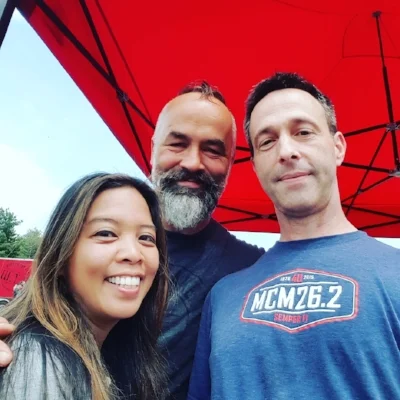I'm a big fan of The History Channel's Forged in Fire series, a timed competition which pits blade smiths against each other in the studio forge to create blades out of anything from golf clubs to junked cars. After two elimination rounds, the final two blade smiths then get to return to their home forges to recreate an historical edged weapon. It's amazing what the smiths can do, and it's made me wonder if I could make a knife of my own. (This is the part where Mark makes some smart comment about me ending up in the emergency room.)
One of the judges on Forged in Fire is Doug Marcaida, an edged weapons specialist and blade designer. He gets to test the blades for strength and sharpness and such by stabbing, hacking, and slashing at everything from rail ties to bamboo to pig carcasses to goo-filled dummy torsos. Then, you wait for him to deliver his signature line: "It will kill." At this point, the contestant receiving the praise will nod his head in thanks. I think if it were me, I'd be doing some air punching, possibly jumping up and down until I embarrass or hurt myself--possibly both.
At some point, I realized that Doug Marcaida is of Filipino descent and studied Filipino Martial Arts (FMA). He took that knowledge, coupled with other styles he learned and created the art called Marcaida Kali. I was intrigued. Of course I had heard of FMA and seen a few videos of the style, typically with a stick as a weapon, but I didn't realize it was being taught the way one goes to learn Karate, Tae Kwon Do, or other such disciplines.
Culture and Heritage
The "Weapons of Moroland" shield--a testament to one's "Filipino-ness."
Blades in general had always fascinated me. Just like every other Filipino home, we had the "Weapons of Moroland" shield adorning our wall growing up. It managed to disappear when we moved to the East coast, and I wish I knew where it was so I could hang it up in my house now. I remember studying the shape of those miniature blades when I was little, outlining them with a finger, allowing them to sheath themselves into my psyche and imagination.
It struck me that this was a part of my culture and heritage, and that it was something I wanted to incorporate into the world of Aren and future books in the Uniting the Heavens series in some way. I went to YouTube and watched Doug's videos. Then, I contacted the Marcaida Kali and made arrangements to visit in Rochester, NY so that I could sit in on a class and observe in person. I wanted to hear the words they used and watch how and understand technique so that I could write better.
Meeting Doug Marcaida
Kuya Doug knows how to throw a good shaka.
We had met Kuya (older brother, a term of respect in the Philippines) Doug at an event at Quantico Marine Corps Base in Virginia. It was a wicked hot day, and there were tons of people there to watch blade smith Jason Knight in the forging demonstration and to watch the martial arts exhibition. They also came to meet Doug and listen to him talk about blades, fighting, and his experiences on Forged in Fire. We ended up buying a DART knife and got some signatures and pictures. I followed up with Doug regarding visiting his studio in Rochester. He wasn't going to be there because of his commitments to Forged in Fire, but he was excited about my visit and put me in good hands with his senior instructors who would be meeting and talking with me.
Jason Knight! But you can't see the kilt he's wearing!
From the first email communication, the Marcaida Kali instructors were the most awesome, gracious, and accommodating hosts. Ka Anthony Chirico worked out the logistics with me and talked about Kuya Doug's passion for the art as well as Doug's love of inspiring others and use of art and imagination as a powerful resource.
I was so pumped. My people!
The Rochester Experience
Planning the Rochester trip was a crazy, last-minute whirlwind activity. I still had important "day job" meetings to call in to while on the trip, and poor Mark occupied himself with running and visiting the local Golds Gym with nothing to dry off from his shower but the roll of paper towels in the bathroom. 😂
Rochester was more than I expected, and offered us some of the best espresso ever (thanks, Founders Cafe!), an International Jazz Festival, and the Old Toad which boasted an impressive scotch list. Yes, of course we spent hours there on two separate nights in order to try as many as possible. And yes, we requested the limited edition Ardbeg Grooves which wasn't even on their list. Points because they had it.
Learning the Ways
Anyway, back to Marcaida Kali...the studio is located on the first floor of the corner of an unassuming business building. In fact, it shares a space with another martial arts discipline. In this humble space, we met senior instructors Ka Anthony Palmer and Ka Jesse Landes, as well as a handful of students--mostly beginners. We watched them warm up, then "spar," and work with the instructors. These students were in street clothes. No gi, no belts. This was a practical art which focused on the art itself. They used rattan sticks, and practice targets were simple pole stands.
Ka Anthony demonstrates technique.
I loved the teaching style, and you could tell how passionate the instructors were. Ka Anthony talked about how he incorporated the teachings into his every day life. I was so inspired that I decided to "pick up the stick" as it were and had some rattan sticks shipped to my house. I'm not trying to be the next master of Marcaida Kali, but I'm all about making myself stronger and more coordinated. (Hoo boy, do I need to work on that coordination bit.)
We talked to Ka Anthony about FMA and how it should be more widely practiced. It's definitely not as popular as other disciplines, but there's no reason why it shouldn't be. As Anthony explained to us, it's more of a lifestyle than just something you do when you're in class. Marcaida Kali focuses on skills like ambidextrous coordination and balance of the whole body. There's more to this art than just hitting and cutting.
Doug has done and continues to do much to promote FMA. He managed to get FMA into the Rochester Institute of Technology (RIT) and also founded the Kali 101 wellness course which is also offered at RIT (currently taught by Anthony Palmer). These classes offer another opportunity for students to learn some of those ambidextrous coordination drills with the rattan sticks. Seriously, where were these classes when I went to college?
Ka Jesse Landes and Ka Anthony Palmer give the class some pointers.
I haven't talked a lot here about what they taught or the details of what I've learned. You'll have to pick up the next books in the Uniting the Heavens series to see how I've been influenced by my studies of Marcaida Kali. I hope you enjoy!







